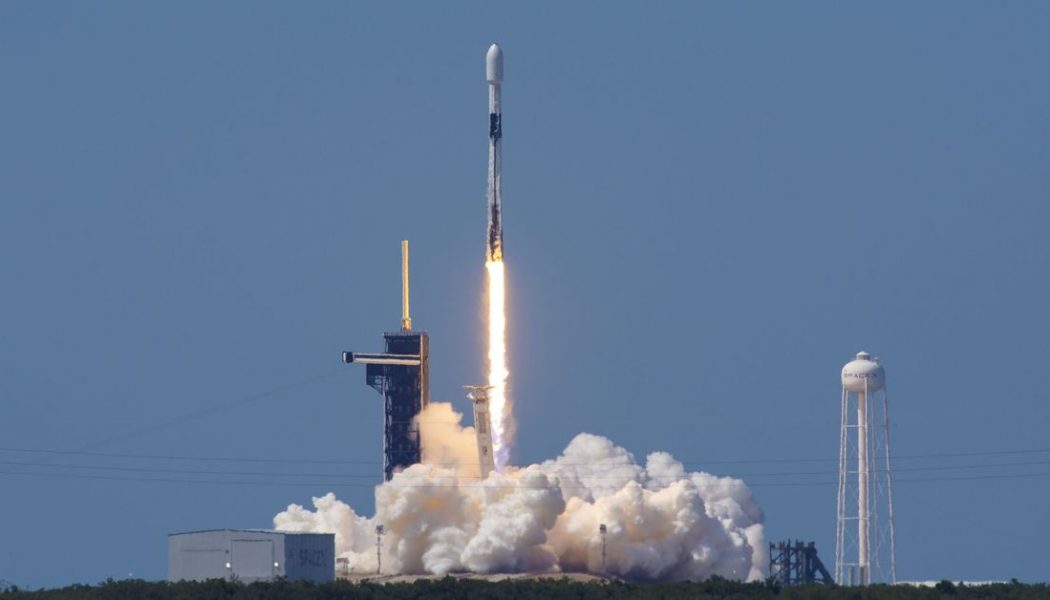
Update July 11th, 9:30AM ET: SpaceX postponed the launch again on Saturday morning, “to allow more time for checkouts.” The company says it will announce a new launch day once it’s confirmed.
Original Story: A little over a week after launching a GPS satellite for the Space Force, SpaceX is back with another launch of its internet-beaming Starlink satellites. The company’s Falcon 9 rocket is slated to take off from Cape Canaveral, Florida, launching 57 Starlink spacecraft as well as two hitchhiking Earth observation satellites from operator BlackSky.
The flight is the latest in SpaceX’s ongoing quest to flesh out its proposed massive Starlink constellation, aimed at providing broadband internet connectivity from space. The company has permission to launch nearly 12,000 Starlink satellites from the Federal Communications Commission, a swarm of spacecraft that will beam internet coverage to every point on the globe. After this launch, SpaceX will have launched 595 of its Starlink satellites (though at least one has come out of orbit, while a few others have failed since making it to space).
The mission is the second Starlink launch to include another company’s satellites along for the ride. Typically, SpaceX has launched its Starlink probes in batches of 60, all by themselves. But on a previous launch in June, SpaceX launched 58 Starlink satellites as well as three tiny imaging satellites from the company Planet. The company Spaceflight, a broker that finds room for satellites on upcoming launches, arranged for the BlackSky satellites to fly on this mission. SpaceX also has its own program to arrange ride-shares on its Falcon 9 rocket, working directly with customers, as it did with the recent Planet ride-share.
The Starlink satellites going up on this launch will all sport a relatively new feature, too. They’re equipped with a deployable visor, known as a sunshade, designed to prevent the sun’s light from reflecting off of the shiniest parts of the satellites, notably the antennas. The goal is to decrease the overall brightness of the Starlink spacecraft while in orbit so that they appear as dark as possible in the night sky. SpaceX already launched one of these sunshades on a previous Starlink flight in early June. This is the first launch where the entire fleet will carry the visor.
SpaceX’s new sunshades are a direct response to concerns that have been raised by the astronomy community about Starlink. After the first launch of SpaceX’s satellites, astronomers noticed just how bright the spacecraft appeared in the sky, and scientists grew worried that such a massive constellation of shiny satellites would interfere with their observations of the universe. To observe distant celestial objects, astronomers often rely on taking long-exposure images of the night sky — and a satellite zooming through an image leaves a bright streak that can ruin an observation.
Following discussion with leading astronomy groups, the sunshade is the latest solution SpaceX has come up with. The company tried coating one of its Starlink satellites in early January to make it appear darker; that solution didn’t dampen the vehicle enough to allay everyone’s fears. More changes could be on the horizon, too, such as changing how the satellites are oriented when they reach their final orbits.
SpaceX’s Falcon 9 was slated for liftoff at 10:54AM ET out of the company’s launchpad at NASA’s Kennedy Space Center in Florida. SpaceX is using one of its used rockets for the mission, a Falcon 9 that has flown to space and back four times before. The rocket will attempt to land on one of SpaceX’s drone ships in the Atlantic following the launch, potentially enabling the vehicle to fly for the sixth time. In June, SpaceX set a new record of landing the same Falcon 9 for a fifth time following a flight; the company could repeat the feat with this mission.
If all goes well, the two BlackSky satellites will deploy first, just over an hour after takeoff. The Starlink satellites will then deploy about 30 minutes after that. SpaceX postponed the original launch date for this mission on July 8th, due to bad weather, and then a second time on July 11th, claiming the company needed more time to checkout the vehicle. When SpaceX is able to launch, the company’s live stream is set to begin about 15 minutes before takeoff.
Update July 8th, 12:00PM ET: SpaceX postponed the launch on July 8th due to bad weather in the area. The company decided to proceed through the countdown of the launch up until one minute before the planned takeoff in order to collect data from the rocket.









